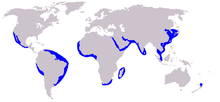- Long-beaked common dolphin
-
Long-beaked Common Dolphin[1] 
Conservation status Scientific classification Kingdom: Animalia Phylum: Chordata Class: Mammalia Order: Cetacea Family: Delphinidae Genus: Delphinus Species: D. capensis Binomial name Delphinus capensis
Gray, 1828Long-beaked Common Dolphin range The Long-beaked Common Dolphin (Delphinus capensis) is a species of common dolphin. It has a more restricted range than the Short-beaked Common Dolphin (D. delphis). It has a disjointed range in coastal areas in tropical and warmer temperate oceans. The range includes parts of western and southern Africa, much of western South America, southern California to central Mexico, coastal Peru, areas around Japan, Korea and Taiwan, and possibly near Oman.[1][3]
Contents
Physical characteristics
The Long-beaked Common dolphin is a medium sized dolphin, smaller than the more popular bottlenose dolphin. Adults range between 1.9 and 2.5 metres (6.2 and 8.2 ft), long, and can weigh between 80 and 235 kilograms (180 and 520 lb), although a range between 80 and 150 kilograms (180 and 330 lb) is more common.[4] Males are generally longer and heavier.[4] The color pattern on the body is unusual. The back is dark and the belly is white, while on each side is an hourglass pattern colored light grey, yellow or gold in front and dirty grey in back.[5] It has a long, thin rostrum with up to 50–60 small, sharp, interlocking teeth on each side of each jaw.[6]
Taxonomy
The Short-beaked Common Dolphin is a member of common dolphin genus, Delphinus within the dolphin family, Delphinidae. Until the mid-1990s, the different forms within Delphinus were not recognized as separate species, but were all considered members of the species D. delphis.[3][4] Currently, there are two recognized species of Delphinus — the Short-beaked Common Dolphin (D. delphis) and the Long-beaked Common Dolphin.[1] The Long-beaked Common Dolphin is generally larger than the Short-beaked Common Dolphin and has a longer rostrum.
The Indo-Pacific Common Dolphin is sometimes considered a separate species (D. tropicalis) but is more often considered a form of the Long-beaked Common Dolphin.[1][3]
Behavior
Long-beaked Common Dolphins can live in aggregations of hundreds or even thousands of dolphins.[3] They sometimes associate with other dolphin species, such as pilot whales.[3] They have also been observed bow riding on baleen whales, and they also bow ride on boats.[3] Breaching behavior and aerial acrobatics are common with this species.[4]
Diet
The Long-beaked Common Dolphin has a varied diet consisting of many species of fish and squid that live less than 200 metres (660 ft) deep.[3]
Reproduction
The Long-beaked Common Dolphin has a gestation period of 10 to 11 months.[4] The newborn calf has a length of between 80 and 100 centimetres (2.6 and 3.3 ft) and a weight of about 10 kilograms (22 lb).[4] Typical interbirth interval ranges from 1 to 3 years.[4] In captivity, the Long-beaked Common Dolphin has hybridized with the Common Bottlenose Dolphin (Tursiops truncatus).[3][7] One of the hybrids has been bred back to a bottlenose dolphin, demonstrating that such hybrids are fertile.[7]
References
- ^ a b c d Mead, James G.; Brownell, Robert L., Jr. (16 November 2005). "Order Cetacea (pp. 723-743)". In Wilson, Don E., and Reeder, DeeAnn M., eds. Mammal Species of the World: A Taxonomic and Geographic Reference (3rd ed.). Baltimore: Johns Hopkins University Press, 2 vols. (2142 pp.). ISBN 978-0-8018-8221-0. OCLC 62265494. http://www.bucknell.edu/msw3/browse.asp?id=14300044.
- ^ Hammond, P.S., Bearzi, G., Bjørge, A., Forney, K., Karczmarski, L., Kasuya, T., Perrin, W.F., Scott, M.D., Wang, J.Y., Wells, R.S. & Wilson, B. (2008). Delphinus capensis. In: IUCN 2008. IUCN Red List of Threatened Species. Downloaded on 7 October 2008.
- ^ a b c d e f g h Perrin, W. (2002). "Common Dolphins". In Perrin, W.; Wursig, B. and Thewissen, J.. Encyclopedia of Marine Mammals. Academic Press. pp. 245–248. ISBN 0-12-551340-2.
- ^ a b c d e f g Shirihai, H. & Jarrett, B. (2006). Whales, Dolphins and Other Marine Mammals of the World. pp. 174–176. ISBN 0-691-12757-3.
- ^ Reeves, Stewart, Clapham, Powell. Guide to Marine Mammals of the World. p. 388. ISBN 0-375-41141-0.
- ^ "The Common Dolphin". http://library.thinkquest.org/17963/genus-Delphinus.html. Retrieved 2008-07-03.
- ^ a b Zornetzer H.R.; Duffield D.A. (October 1, 2003). "Captive-born bottlenose dolphin × common dolphin (Tursiops truncatus × Delphinus capensis) intergeneric hybrids". Canadian Journal of Zoology (NRC Research Press) 81 (10): 1755–1762. doi:10.1139/z03-150. http://www.ingentaconnect.com/content/nrc/cjz/2003/00000081/00000010/art00014?crawler=true.
External links
Categories:- IUCN Red List data deficient species
- Oceanic dolphins
- Megafauna
- Fauna of the Atlantic Ocean
- Fauna of the Pacific Ocean
Wikimedia Foundation. 2010.


